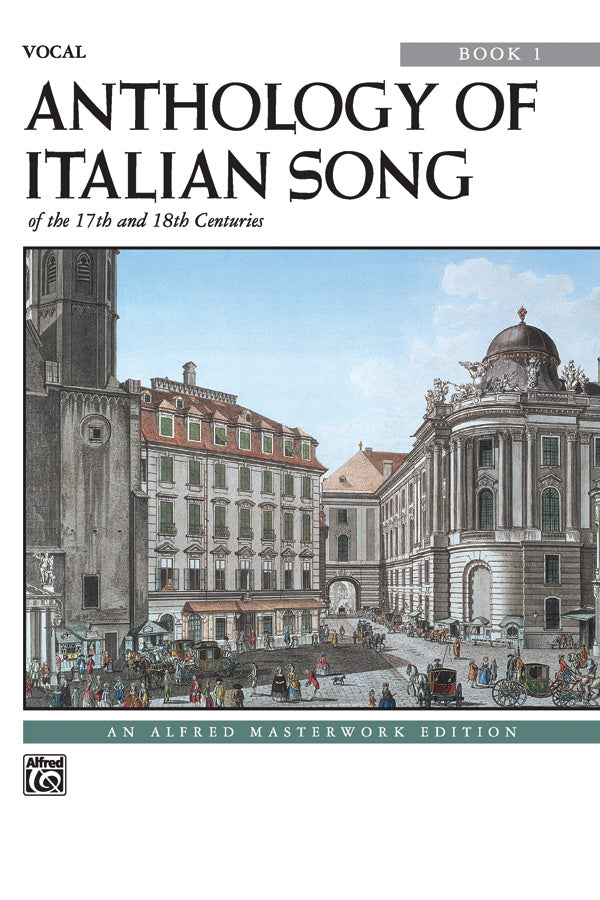Anthology of Italian Songs of the 17th and 18th Centuries - Book 1
Expected to ship in about a week.
- Composers: George Frideric Handel (1685-1759), Niccolò Jommelli (1714-1774), Domenico Scarlatti (1685-1757), Alessandro Parisotti (1853-1913), Antonio Caldara (1670-1736), Antonio Cesti (1623-1699), Giovanni Battista Pergolesi (1710-1736), Tommaso Traetta, Giacomo Carissimi (1605-1674), Giovanni Legrenzi (1626-1690), Antonio Lotti (1667-1740), Giovanni Paisiello (1740-1816), Christoph Willibald Gluck (1714-1787), Benedetto Marcello (1686-1739), Alessandro Scarlatti (1660-1725), Jean-Paul-Égide Martini (1741-1816), Giovanni Maria Bononcini (1642-1678), Niccolò Piccinni (1728-1800), Antonio Vivaldi (1678-1741)
- Instrumentation: Piano, Voice, Basso continuo, Keyboard, Soprano, Orchestra, Bass, Opera
- Work Languages: English, Italian
- UPC:
- Size: 6.9 x 10.6 inches
- Pages: 144
Description
A standard in the vocalist's repertoire. Perfect for students.
Works:
- Carissimi: Vittoria, mio core!
- Intorno all'idol mio from Cesti: Orontea
- Legrenzi: Che fiero costume from Eteocle e Polinice (1674)
- Bononcini: Deh più a me non v'ascondete
- O cessate di piagarmi from A. Scarlatti: Pompeo
- Se Florindo è Fedele from A. Scarlatti: La donna ancora è fedele (1698)
- Son tutta duolo from A. Scarlatti: La donna ancora è fedele (1698)
- A. Scarlatti: Spesso vibra per suo gioco from La caduta de' Decemviri (1697)
- A. Scarlatti: Se tu della mia morte from La caduta de' Decemviri (1697)
- Un certo non se che from Vivaldi: Arsilda, regina di Ponto (1716)
- Lotti: Pur dicesti, o bocca bella
- Sebben, crudele from Caldara: La Costanza in amor vince l'inganno
- Caldara: Selve amiche, ombrose piante
- Caldara: Come raggio di sol
- Consolati e spera! from Scarlatti: Ifigenia in Tauri
- Affanni del pensier from Handel: Ottone, HWV 15
- Ah! mio cor from Handel: Alcina, HWV 34
- B. Marcello: Quella fiamma che m'accende ("Il mio bel foco")
- Pergolesi: Ogni pena più spietata from Lo frate 'nnamorato (1732)
- Stizzoso, mio stizzoso from Pergolesi: La serva padrona (1733)
- Parisotti: Se tu m'ami (1885)
- O del mio dolce ardor from Gluck: Paride ed Elena, Wq. 39
- Chi vuol comprar la bella calandrina from Jommelli: L'Uccellatrice
- Ombra cara, amorosa from Traetta: Antigona
- Piccinni: O notte, o Dea del mistero
- Paisiello: Chi vuol la zingarella from I zingari in fiera, R 1.79
- Paisiello: Nel cor più non mi sento from La molinara (1790)
- Paisiello: Il mio ben quando verrà from Nina, o sia La pazza per amore (1790)
- J. Martini: Plaisir d'amour (1784)
Publishers use a lot of words to describe what they sell, and we know it can be confusing. We've tried to be as clear as possible to make sure you get exactly what you are looking for. Below are descriptions of the terms that we use to describe the various formats that music often comes in.
Choral Score
A score for vocalists that only contains the vocal lines. The instrumental parts are not there for reference. Generally, cheaper than a vocal score and requires multiple copies for purchase.
Facsimile
Reproductions of the original hand-written scores from the composer.
Full Score
For ensemble music, this indicates that the edition contains all parts on a single system (there are not separate parts for each player). In larger ensembles, this is for the conductor.
Hardcover
Hardbound. Generally either linen-covered or half-leather.
Orchestral Parts
Similar to a wind set, this is a collection of parts. In the case of strings, the numbers listed are the number of copies included, though generally these are available individually (often with minimum quantities required).
Paperback
When publishers offer multiple bindings (e.g. hardcover) or study scores, this is the "standard" version. If you're planning to play the music, this is probably what you want.
Performance / Playing Score
A score of the music containing all parts on one system, intended for players to share. There are not separate parts for each player.
Set of Parts
For ensemble music, this indicates that there are separate individual parts for each player.
Solo Part with Piano Reduction
For solo pieces with orchestra, this is a version that contains a piano reduction of the orchestra parts. For piano pieces, two copies are typically needed for performance.
Study Score
A small (think choral size) copy of the complete score meant for studying, and not playing. They make great add-ons when learning concertos and small chamber works.
Vocal Score
A score prepared for vocalists that includes the piano/organ part or a reduction of the instrumental parts.
Wind Set
For orchestral music, this is a collection of wind and percussion parts. The specific quantities of each instrument are notated.
With Audio
In addition to the printed music, the edition contains recordings of the pieces. This may be an included CD, or access to files on the internet.
With / Without Fingering (Markings)
Some publishers prepare two copies - a pure Urtext edition that includes no fingering (or bowing) suggestions and a lightly edited version that includes a minimal number of editorial markings.


